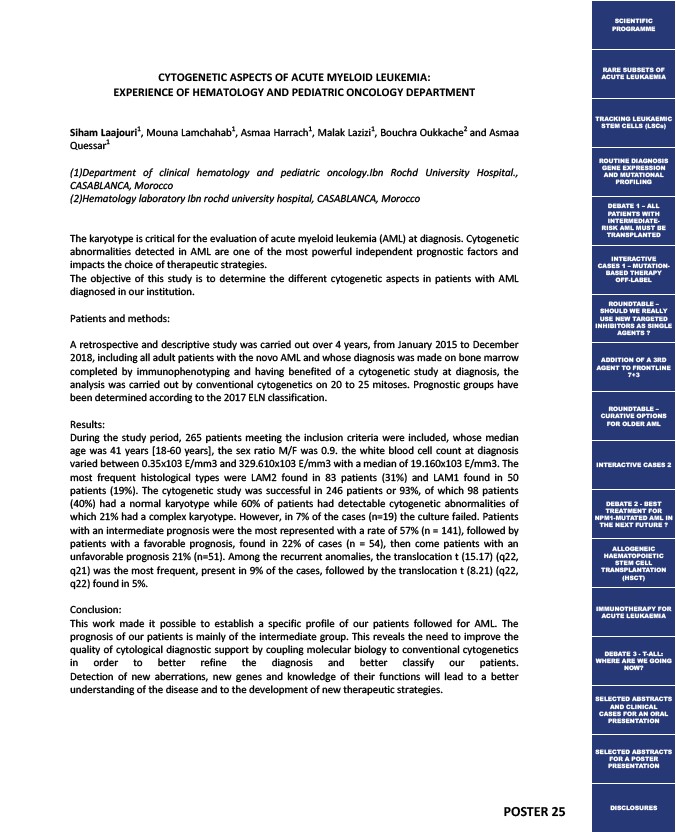
POSTER 25
CYTOGENETIC ASPECTS OF ACUTE MYELOID LEUKEMIA:
EXPERIENCE OF HEMATOLOGY AND PEDIATRIC ONCOLOGY DEPARTMENT
Siham Laajouri1, Mouna Lamchahab1, Asmaa Harrach1, Malak Lazizi1, Bouchra Oukkache2 and Asmaa
Quessar1
(1)Department of clinical hematology and pediatric oncology.Ibn Rochd University Hospital.,
CASABLANCA, Morocco
(2)Hematology laboratory Ibn rochd university hospital, CASABLANCA, Morocco
The karyotype is critical for the evaluation of acute myeloid leukemia (AML) at diagnosis. Cytogenetic
abnormalities detected in AML are one of the most powerful independent prognostic factors and
impacts the choice of therapeutic strategies.
The objective of this study is to determine the different cytogenetic aspects in patients with AML
diagnosed in our institution.
Patients and methods:
A retrospective and descriptive study was carried out over 4 years, from January 2015 to December
2018, including all adult patients with the novo AML and whose diagnosis was made on bone marrow
completed by immunophenotyping and having benefited of a cytogenetic study at diagnosis, the
analysis was carried out by conventional cytogenetics on 20 to 25 mitoses. Prognostic groups have
been determined according to the 2017 ELN classification.
Results:
During the study period, 265 patients meeting the inclusion criteria were included, whose median
age was 41 years 18-60 years, the sex ratio M/F was 0.9. the white blood cell count at diagnosis
varied between 0.35x103 E/mm3 and 329.610x103 E/mm3 with a median of 19.160x103 E/mm3. The
most frequent histological types were LAM2 found in 83 patients (31%) and LAM1 found in 50
patients (19%). The cytogenetic study was successful in 246 patients or 93%, of which 98 patients
(40%) had a normal karyotype while 60% of patients had detectable cytogenetic abnormalities of
which 21% had a complex karyotype. However, in 7% of the cases (n=19) the culture failed. Patients
with an intermediate prognosis were the most represented with a rate of 57% (n = 141), followed by
patients with a favorable prognosis, found in 22% of cases (n = 54), then come patients with an
unfavorable prognosis 21% (n=51). Among the recurrent anomalies, the translocation t (15.17) (q22,
q21) was the most frequent, present in 9% of the cases, followed by the translocation t (8.21) (q22,
q22) found in 5%.
Conclusion:
This work made it possible to establish a specific profile of our patients followed for AML. The
prognosis of our patients is mainly of the intermediate group. This reveals the need to improve the
quality of cytological diagnostic support by coupling molecular biology to conventional cytogenetics
in order to better refine the diagnosis and better classify our patients.
Detection of new aberrations, new genes and knowledge of their functions will lead to a better
understanding of the disease and to the development of new therapeutic strategies.
SCIENTIFIC
PROGRAMME
RARE SUBSETS OF
ACUTE LEUKAEMIA
TRACKING LEUKAEMIC
STEM CELLS (LSCs)
ROUTINE DIAGNOSIS
GENE EXPRESSION
AND MUTATIONAL
PROFILING
DEBATE 1 – ALL
PATIENTS WITH
INTERMEDIATE-RISK
AML MUST BE
TRANSPLANTED
INTERACTIVE
CASES 1 – MUTATION-BASED
THERAPY
OFF-LABEL
ROUNDTABLE –
SHOULD WE REALLY
USE NEW TARGETED
INHIBITORS AS SINGLE
AGENTS ?
ADDITION OF A 3RD
AGENT TO FRONTLINE
7+3
ROUNDTABLE –
CURATIVE OPTIONS
FOR OLDER AML
INTERACTIVE CASES 2
DEBATE 2 - BEST
TREATMENT FOR
NPM1-MUTATED AML IN
THE NEXT FUTURE ?
ALLOGENEIC
HAEMATOPOIETIC
STEM CELL
TRANSPLANTATION
(HSCT)
IMMUNOTHERAPY FOR
ACUTE LEUKAEMIA
DEBATE 3 - T-ALL:
WHERE ARE WE GOING
NOW?
SELECTED ABSTRACTS
AND CLINICAL
CASES FOR AN ORAL
PRESENTATION
SELECTED ABSTRACTS
FOR A POSTER
PRESENTATION
DISCLOSURES